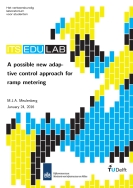Traffic management measures are implemented successfully in practice like in the Field Operational Test ‘Praktijkproef Amsterdam’. With increasing congestion every year on Dutch freeways, improvement of existing traffic management measures are necessary. One of these measures is ramp metering. Ramp metering regulates the inflow from the onramp on to the mainline of the freeway. In the thesis the focus is on traffic-responsive local ramp metering. A commonly used ramp-metering algorithm is the ALINEA algorithm. A variation of this algorithm is used in the Praktijkproef Amsterdam (PPA). This variation, with density as traffic variable, uses a parameter estimator, which estimates the critical density every time step and this critical density is used to update the target value in the ramp metering algorithm. The gain parameter in the ALINEA algorithm has always been fixed in field experiments, but it is unknown if updating this parameter can improve the current ramp metering approaches. This updating process in every time step is called adaptive control and is tested in this research.
This thesis uses the model-reference adaptive control (MRAC) approach with a modified PI-ALINEA as control law. The MRAC approach will use the gradient method to update the parameter gains of the PI-ALINEA. The Parameterschatter will determine the critical density every time step and updates the target density. The standard D-ALINEA and the standard PI-ALINEA will be used to compare the new developed approach with. For this comparison the macroscopic METANET model is used. The simulated network consists of a stretch of freeway of 30 kilometres with one on-ramp at 20 kilometres. An increasing demand over time was used for the mainline as well as for the demand on the onramp. The new adaptive ramp-metering controller (AD-RMC) was tested in three different ways: only with the Parameterschatter, only with the gradient method and a complete AD-RMC with the gradient method and with the Parameterschatter.
The results showed that the AD-RMC with the Parameterschatter or the gradient method active gives the best results in terms of total time spent (TTS) and total delay. The PI-ALINEA gives the best results of the standard variations without estimator(s). The total AD-RMC with both estimators gives less good results as the other AD-RMC variations and is also less stable. For a final check the AD-RMC with the Parameterschatter only and with the gradient method only were simulated with a different demand profile. The results coming from this validation confirm that the algorithms also work under different conditions. It is recommended to not directly implement this new approach in practice. It has potential to be a ramp metering algorithm implemented in practice but further research is recommended. However, the standard PI-ALINEA can be implemented and tested by means of a Field Operational Test (FOT). It is also worth looking into a more stable parameter gain update method, as this thesis proves that changing the gains every time step has some benefit on the behaviour of ramp metering algorithm.
